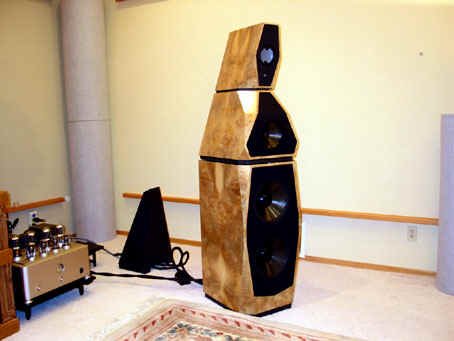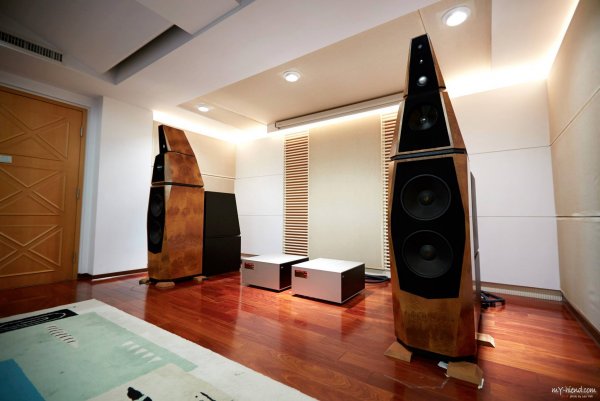I have heard them. Hard to pass judgement really as they were in a show. They remind me of Torquemada. Very scary looking.I wonder what ever happened to these speakers? Has anyone ever heard them?
Tesseract, an overview from an Avalon insider's perspective
- Thread starter Steve Huntley -Avalon
- Start date
You are using an out of date browser. It may not display this or other websites correctly.
You should upgrade or use an alternative browser.
You should upgrade or use an alternative browser.
Is the Tesseract made of that blue stuff from the Avengers?
It was said, that the white paper of the Tesseract was specifying, that the Avalon Top Speaker should not compromise the Music Staging because of speaker reflections. The most speakers are placed to close to the corners, the side and rear wall reflections will be reflected on the speakers rear and side shape again.
So the speaker should work as a diffusor for this type of reflections, otherwise the signal becomes unprecise.
The Tesseract is built accordingly, so the Design is a technical "form follows function" one.
I wish I can get to hear the big ones like Tesseract and the ones Winston Ma had
The Winston Ma listening room always shows the Avalon Sentinel speaker, the model before Tesseract.
Sentinel and Tesseract both have an active bass section (similar to Magic M9). Rumors are saying, the the Avalon development partner for the Sentinel bass amplifier was Classe Audio.
Speaking to Sentinel owners, some of them seem to still prefer the former full passive flagship model from Avalon, the Osiris.
As the main amplifier is driving the complete speaker, the result is more coherent.
The Avalon Osiris was a kind of 450kg Monster, only the 2 level external cross over was close to 200kg each side...
The external crossover for the Sentinel was much more handy
Avalon Sentinel in Winston Ma's room (the small black triangle corpus is the external crossover):

Avalon Osiris (the 4 big black boxes behind the speakers are the external cross over) :

Avalons are one off my favorite cones, with Zellaton and YG. But they require massive space from the walls. I wish I can get to hear the big ones like Tesseract and the ones Winston Ma had
Do they beat DeVore ..?
Has anyone heard these speakers? I see they now retail for over £700K...initial comments from those who have heard is very positive...that said the price places it firmly in the WAMM, Magico M9 class. Would appreciate hearing from those who have heard it.
Your dream Arrakis are much better...and cheaperHas anyone heard these speakers? I see they now retail for over £700K...initial comments from those who have heard is very positive...that said the price places it firmly in the WAMM, Magico M9 class. Would appreciate hearing from those who have heard it.
Thanks Howiebrou! That was quick! How's things? On our end, I am going to wait another 2 weeks or so but will be posting again about Entreq Pluton and their Tungsten-generation line.Your dream Arrakis are much better...and cheaper
Any thing new with you?
Few things I am toying with but no hard and fast decisions yet. Trying to simplify the set up mainly.Thanks Howiebrou! That was quick! How's things? On our end, I am going to wait another 2 weeks or so but will be posting again about Entreq Pluton and their Tungsten-generation line.
Any thing new with you?
Fair enough. On our side, the system appears to be headed in the right direction towards a 'fully evolved status'. We shall see. The only element which is likely to go under scrutiny before we call this system 'fully evolved' is the sub. Otherwise, it appears to have been completed in the last 2-3 years. More to come in a few weeks.
An interesting opinion. The Arrakis tech is 15+ years old, Rockport has iterations of newer (and presumably) lower distortion drivers + better cabinet tech. And the Wilsons and Magicos are much newer tech and essentially equally huge speakers.Your dream Arrakis are much better...and cheaper
I see your point. I don't necessarily subscribe to better is new. All I can go by is having heard them on the Arrakis is 100% my preferred speaker. That might just be my preference, of course.An interesting opinion. The Arrakis tech is 15+ years old, Rockport has iterations of newer (and presumably) lower distortion drivers + better cabinet tech. And the Wilsons and Magicos are much newer tech and essentially equally huge speakers.
Steve, you will get the hang of it! Hyperbole is in no short supply in high-end audio. WBF Members tend to like facts more than feelingsThanks for the follow up questions and comments guys.
Easy question first...US retail is $325k for a pair. It's probably obvious that it takes quite a bit of time to build a pair of these (two months minimum) so in North America there are no more than two pairs made available per year. The others go overseas. So they are a highly exclusive offering not only from the price standpoint but from the availability standpoint.
If Higherfi.com has a pair listed then I would be highly suspicious...we certainly know exactly where every pair is and they don't have a pair, it's that simple. Nor do they have access to them through us or our distribution partners.
Regarding my admittedly bold comments/statements...it was of course only based on what my personal experiences are and have been. I think it's obvious that I have a bias and I assume people just take it as an opinion of one person (with an obvious bias). My comments (raves) weren't intended as all knowing blanket statements. My apologies if I didn't put it in clearer context. I stand by my comments though from the perspective of my personal experiences.
Ok, onto the other questions:
Damping of cabinet vibrations. With the huge amount of bass energy capable of being produced, it absolutely needs to be dealt with in a serious way from the standpoint of cabinet design. There are a number of things that had to be been done on Tess that aren't as necessary on other Avalon cabinets...at least not to the same degree. Some specific things are the fact the faceted front Avalon cabinets have the panels and bracing mitered for all joints...no butt joints. An Avalon cabinet would stay together without any of the glue used simply by the fact that all the joints are so tight and the cabinets are assembled using fire hose presses with extremely high pressure. A typical speaker cabinet would crush to pieces under that pressure. Glue is used mainly to seal the joints in terms of minor air gaps...only partly to hold the cabinet together. I doubt an Avalon cabinet could be pulled apart even without glue. Anyway, thats one important feature. Another is the fact that the Woofers have extremely stiff baskets and that the front woofer is coupled (bolted) to the pole piece of the woofer behind it. That one is constrained and damped to a heavy center brace. Multiple materials are used where needed, different thicknesses of material are constrained, etc. Also the Tess cabinets are designed somewhat like a geodesic dome concept where each facet/panel transfers energy to the adjacent panel and all the energy is dispersed across the entire structure. I could go on and on about the structural rigidity of these cabinets (and all Avalons for that matter) but I think you get the idea. The structure is quite sufficient and rigid for the challenging application of minimizing and controlling/tuning resonance.
Type of load presented o amplifier. The amplifier will see a completely non-reactive load, it's a very resistive load. Tess is extremely easy to drive.
What amps or design topologies of amplifiers do we like with Tess. At the risk of sounding overly diplomatic on this, it really is up to the listener. Basically the function of an ideal amplifier is to provide infinite power in an infinitely short period of time. Since no amplifier realistically does that, it's a matter of choosing one that either has the fewest compromises in accomplishing that or that has a sonic signature that you personally want imparted on the sound. We certainly hear the merits of using an amplifier with incredible transient speed (Spectral is a perfect example). However great sound can be attained using an 18 watt triode tube amp...really whatever flavoring you want to choose. Power ratings really aren't that helpful in determining what an amplifier will deliver musically into a load. A 1k tone into a 8 ohm resistor really has very little with what an amplifier is doing when driving a musical signal into a transducer. A lot of variables at play to say the least.
Dimensions of Tess. Height is about 7' 3". Maximum width of speaker itself is 2' 5". Maximum depth of speaker is 2' 8". The base is only slightly deeper and wider than the widest/deepest points of the Sub cabinet. Each Tess weighs in at 827 lbs out of the crates. The pair of speakers are shipped in 4 crates and the subs have a built in dolly system to get them out of the crates, basically down a built in ramp. Two strong guys can install a pair of Tess once the crates are in the room.
Special crossover materials. Indeed there are. The custom designed wiring alone in a Tess costs a small fortune. Probably 30-40% of the crossover parts in Tess are specially developed parts that most closely resemble the ideal of that type of part. All Avalon inductors are very carefully hand wound using special custom wire, capacitors were developed specifically for the needs within a speaker crossover...special materials and manufacturing techniques were required. Probably 30-40% of the crossover parts for Tess were either newly discovered or custom made. The benefits of these efforts to find the perfect parts will be made available in other Avalon models going forward. The current Indra Ceramic and Diamond in fact include this technology now.
Adjustability. There are two user adjustable controls on Tess. One is the master gain which adjusts the balance in output of the sub and upper cabinet. This would typically be set to zero but there are 1/4 dB steps in either direction to a maximum of 2.5 dB plus or minus. There is also a Speed mode/Extended mode switch. This can be useful if a room is not fully treated for low frequency control with helmholtz resonators, traps, etc. Basically the switch changes the Q from .4 in speed mode to .5 in extended mode. The benefits of this would depend on the room, the content, and the desire to maintain bowel control
Grounding. On Tess the cabinet is indeed grounded to the ground terminal on the AC input. I'm not sure if a separate grounding post might be employed in future products but I will bring that up for sure.
I don't think I'll get drawn into a debate about my opinions or conclusions. I will do my best to stick more to facts in the future though as I'm sure thats more valuable in this context.
Respectfully,
Steve
7 years later one would hope...Steve, you will get the hang of it! Hyperbole is in no short supply in high-end audio. WBF Members tend to like facts more than feelingsYour passion and enthusiasm are duly noted and, IMHO, essential for success in our highly competitive industry. I wish you every success with Avalon!
Similar threads
- Replies
- 0
- Views
- 268
- Replies
- 9
- Views
- 557
- Replies
- 3
- Views
- 434
- Replies
- 19
- Views
- 1K
| Steve Williams Site Founder | Site Owner | Administrator | Ron Resnick Site Owner | Administrator | Julian (The Fixer) Website Build | Marketing Managersing |

